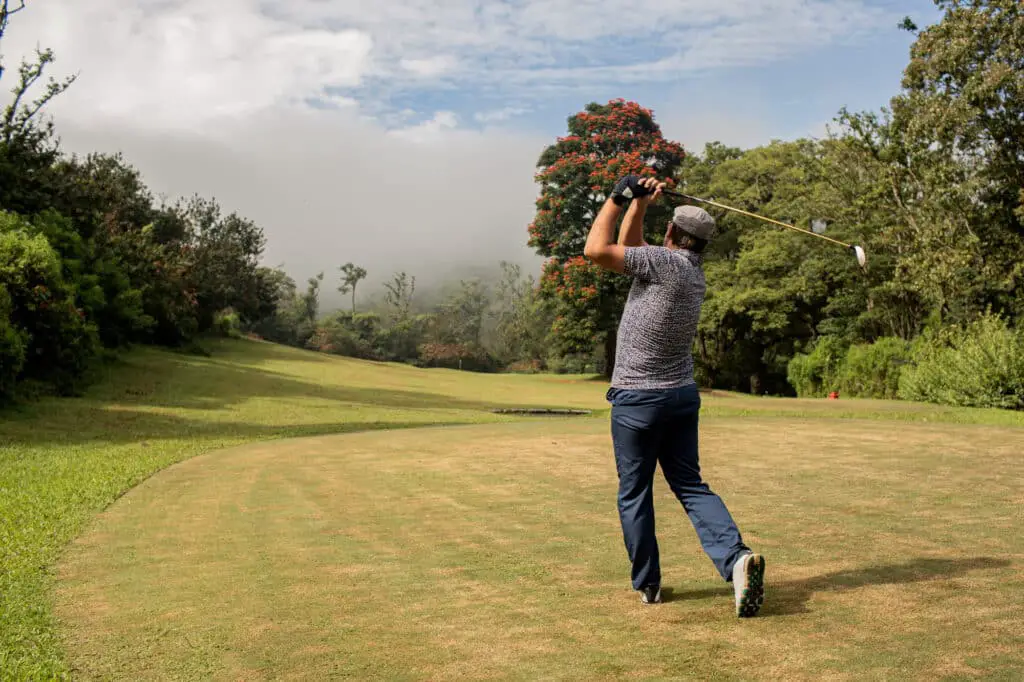Last Updated on June 6, 2023
Are you an avid golfer looking to take your game to the next level? Are you struggling with early extension in your golf swing and not sure how to address it? An early extension can be one of the most difficult issues for any player to overcome, but there are ways to stop it. In this article, we will discuss some key tips on how to stop early extension in golf swing from getting in the way of a successful drive. Read on!
Causes of Early Extension in the Golf Swing
Early extension in the golf swing is when a golfer’s back straightens before impact, leading to an inaccurate shot. This can be caused by several different factors, which we will discuss further on the next sections. So, to avoid early extensions, you need to understand the physics of balls swing. Let’s go!
Understand Ball Flight Physics and Clubface Positioning During the Swing
It is important to understand ball flight physics and clubface positioning during the swing in order to stop early extension. The key elements of a good golf swing are grip pressure, weight transfer, and correct swing mechanics. During the backswing, it’s essential that you maintain even grip pressure through your hands while transferring your body weight away from the target. This helps ensure proper clubface alignment for a powerful impact with the ball.
Moreover, maintaining balance throughout the entire swing sequence will help keep your arms extended without any unnecessary movement or changes in posture. To achieve this balance, be mindful of your weight shift as you rotate your upper body and lower body around an axis point near your spine.
Properly timing these shifts can help prevent early extension and create more distance off the tee box or fairway. With practice and patience, understanding how these elements interact with each other will lead to improved accuracy on all your shots.
Analyse Your Grip Pressure and Posture During the Swing
Now that you understand the physics and clubface positioning of a golf swing, it is important to analyse your grip pressure and posture during the swing to stop early extension. A proper grip pressure ensures that all parts of the body are working together throughout the entire swing. Posture must be maintained for consistent ball flight direction.
| Grip Pressure | Posture | Swing Pressure |
|---|---|---|
| Light | Straightened Spine | Firm |
| Consistent | Head Over Ball | Balanced |
When analysing your grip pressure and posture during a golf swing, make sure both hands have an equal hold on the club; this will help maintain control over the ball. Additionally, focus on keeping your back straight and head directly over the ball while addressing it. This helps keep everything aligned so there’s less room for error during impact with the ball.
As you start to take your backswing, apply a firm but balanced amount of pressure throughout your arms and upper body – as well as core muscles – ensuring consistency through each motion of the swing. Doing this allows you to generate more power without sacrificing accuracy or creating any extra movement from early extension.
Utilise Proper Weight Transfer During the Swing

Weight transfer is a critical component of the golf swing. To stop early extension, you must understand how to properly shift your weight during the swing to maintain good mechanics and clubface positioning. The key is to focus on transferring your weight from your back foot towards the target as you take the club away from the ball. During this transition, it’s important that you keep your grip pressure light and use a slow, smooth tempo for maximum control.
The goal of proper weight transfer is to create power without sacrificing accuracy or consistency. This can be achieved by keeping your body centred throughout the entire motion – meaning no swaying off balance or leaning too far forward or backwards at any point in the downswing. When done correctly, shifting your weight will allow you to hit longer shots while still maintaining a consistent strike pattern.
Practice Drills to Improve Balance, Timing, and Tempo
Once you have established proper weight transfer during your golf swing, the next step in preventing early extension is to focus on balance and timing drills. There are several different types of practice drills that can improve your balance, timing, tempo, and grip pressure:
- Weight Transfer Drills – These drills help maintain a consistent weight shift throughout the entire golf swing. They also promote proper sequencing from the start position to impact.
- Balance Drills – Balancing exercises strengthen muscles for stability and control during the backswing and follow-through phases of the golf swing. This helps prevent overuse injuries caused by incorrect body mechanics.
- Timing Drills – Proper timing is essential to ensure an efficient release at impact. Focus on hitting balls with precise rhythm and flow to develop better coordination between arms and legs while swinging the club.
- Grip Pressure Drills – Improving your grip pressure will help reduce tension when holding onto the club during your swing, thus allowing more freedom of movement through impact which prevents early extension. Additionally, it ensures more power behind each shot as well as greater accuracy overall.
These practice drills should be done regularly so that they become ingrained into your muscle memory and ultimately lead to improved performance on the course.
Frequently Asked Questions
What Are the Best Drills to Help Improve My Golf Swing?
There are several effective drills that can help improve your golf swing and prevent early extension. These include the early extension drill, grip pressure drill, weight transfer drill, clubface position drill, and ball flight drill.

The early extension drill is designed to teach you how to stay in balance throughout your entire swing. The grip pressure drill requires squeezing the club lightly for a few seconds at address before beginning your backswing.
The weight transfer drill encourages fluid movement from the backswing through impact by emphasising shifting of weight onto the left side during the backswing and then onto the right side through impact. The clubface position drill focuses on getting into an ideal starting setup by rotating the wrists slightly outward so that they’re parallel when looking down at the ball prior to hitting it. Finally, using a ball flight monitor or tracking device can give you instant feedback about your contact with the ball which will show up in any flaws in its trajectory or spin rate.
How Can I Tell if I Am Suffering From Early Extension in My Golf Swing?
Common indicators include bending too far forward during your backswing, swaying away from the ball while trying to hit it, or pushing your hips toward the target when swinging down. All of these are indications that you may be experiencing an excessive amount of body movement before making contact with the ball. To help diagnose early extension more accurately, try recording yourself performing practice swings on video so that you can observe any movements that could point to this problem.
How Much Grip Pressure Should I Be Applying to the Golf Club?
Generally speaking, lighter is better than heavier. Excessive tension puts more strain on your muscles, making it harder to make a fluid motion with the clubhead throughout the swing. The goal is to maintain just enough grip pressure so that you don’t lose control of the clubhead but still allow yourself some freedom of movement through impact. Experimenting with different levels of grip pressure during practice sessions can help you determine what works best for you and your golf swing.
To ensure maximum performance from each shot, focus on keeping your hands relaxed while maintaining a light yet firm grip on the handle of the golf club. This will enable a smoother transition between each stage of the swing and promote consistency in ball flight and accuracy.
How Can I Ensure I Am Transferring My Weight Correctly During the Golf Swing?
Below are three tips for properly shifting your weight during your golf swing:
- Start by setting up in the correct position before taking a practice swing. Make sure your feet are shoulder-width apart and that they’re firmly planted on the ground with your weight evenly distributed between them. This will help establish a strong foundation from which you can start transferring your weight effectively when you begin swinging.
- As you start making your backswing, try to keep most of your body weight over the inside of your front foot throughout the entire motion. Doing this will help prevent any early extension or swaying from side to side, which could cause power loss and consistent inaccuracy in shots.
- Practice maintaining good posture throughout the entire process by keeping your head still and spine straight while completing both parts of the golf swing – backswing and downswing – without breaking form until after impact has been made with the ball.
Following these simple steps should give you greater control over where your body weight is going during each shot.
How Does the Clubface Position Affect Ball Flight?
The clubface position of a golf club is an important factor in determining the ball’s flight during a swing. The way the clubface aligns with the body and interacts with grip pressure and weight transfer all play a role in delivering maximum accuracy and distance when striking the ball.
With that being said, it’s essential to understand how changes in your grip pressure or weight shift can influence the angle at which you make contact with the ball. This means that if the clubface is not correctly aligned, any slight change could send your shot off-course. Additionally, having proper form can help ensure your clubface remains square throughout your entire swing sequence for better trajectory control, spin rate, and directionality.
Conclusion
I’ve learned a lot about how to stop early extension in golf swing from this article. Taking the time to practice drills that focus on grip pressure, weight transfer and clubface position will help me take better shots with less effort.



